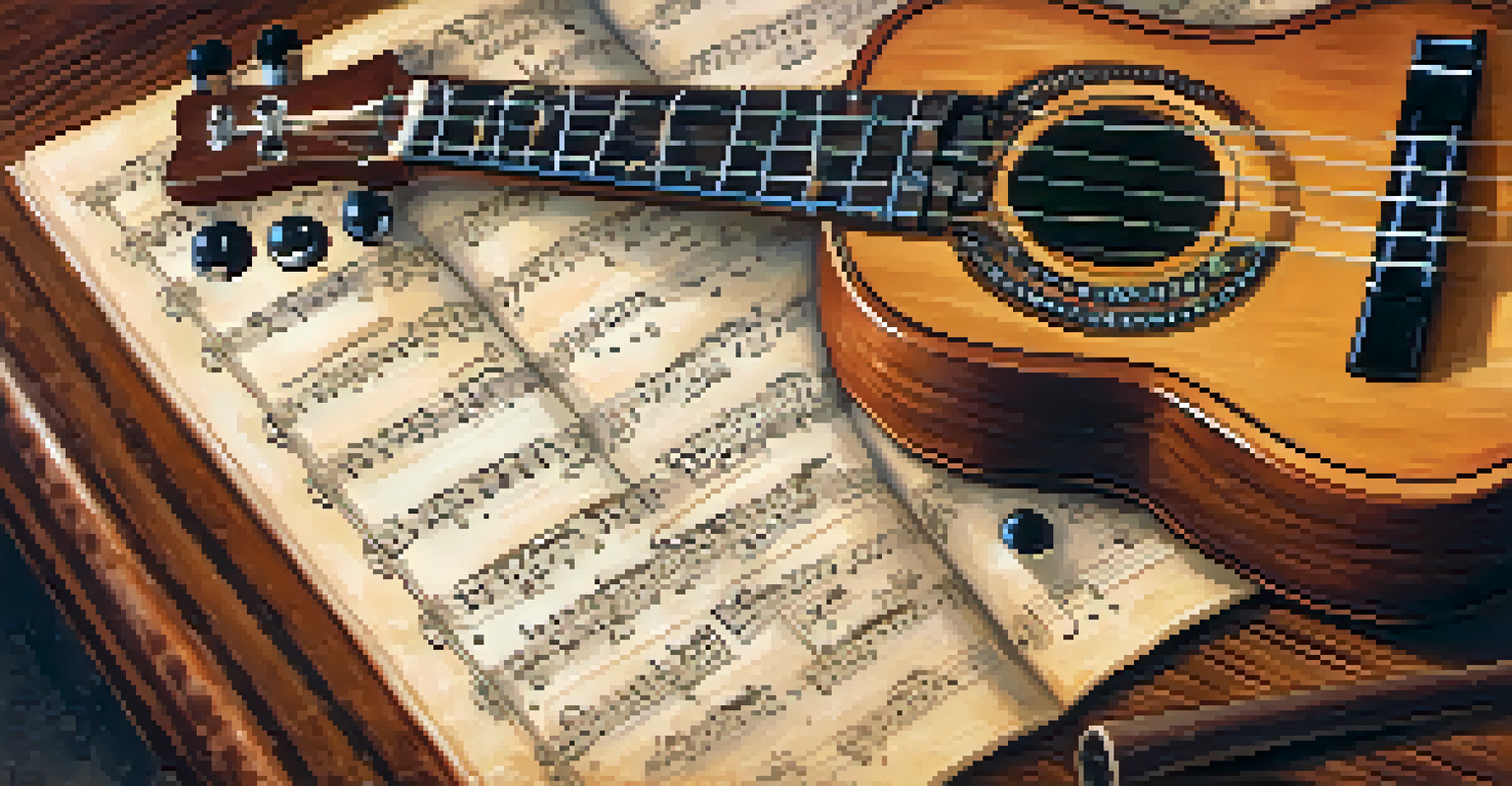Understanding Rhythm: Key to Transcribing Songs for Ukulele

What is Rhythm and Why It Matters in Music
Rhythm is the backbone of music; it's what gives a song its structure and feel. In simplest terms, rhythm refers to the timing of notes and chords in a piece. Without rhythm, music would be a series of random notes, lacking coherence and flow.
Rhythm is the soul of music, the pulse that drives us forward.
Think of rhythm as the pulse of a song, similar to how your heart beats steadily to keep you alive. When you tap your foot or nod your head along to a tune, you're responding to its rhythm. This universal language of beats and timing is vital for any musician, especially those playing the ukulele.
By understanding rhythm, you can better transcribe songs for the ukulele, allowing you to capture the essence of the music. This foundational knowledge not only enhances your playing but also enriches your overall musical experience.
Different Rhythmic Patterns and Their Uses
Rhythmic patterns can vary greatly across genres, each bringing its own flavor to the music. For example, a steady four-beat pattern is common in pop music, while a syncopated rhythm might be found in jazz. Recognizing these patterns helps you identify the feel of a song and how to approach transcribing it.

Consider a simple example: the classic backbeat in rock music, where the snare drum hits on beats two and four. This creates a driving force that listeners can easily latch onto. When you're transcribing a rock song for the ukulele, incorporating this rhythm can make your rendition feel authentic.
Rhythm is Essential in Music
Understanding rhythm enhances your music experience and is crucial for accurately transcribing songs on the ukulele.
Understanding the various rhythmic patterns allows you to choose the right approach when playing a song. As you become familiar with these patterns, you'll find it easier to translate them onto your ukulele, giving your playing a professional touch.
How to Identify Rhythms in Songs
Identifying rhythms in songs can initially seem daunting, but it’s a skill that improves with practice. Start by listening carefully and try to tap along to the beat. This active engagement helps you internalize the rhythm, making it easier to transcribe later.
To play a wrong note is insignificant; to play without passion is inexcusable.
Once you’ve established the beat, break the song down into smaller sections. Focus on the main rhythm first, then listen for variations in different parts of the song. This methodical approach will clarify the rhythmic structure, allowing you to capture it accurately on your ukulele.
Don’t hesitate to use tools like a metronome or a slow-downer app to assist you. These resources can help you isolate rhythms and understand their nuances, ultimately enhancing your transcription skills.
Practicing Rhythm with a Metronome
A metronome is an invaluable tool for developing your rhythmic skills. By setting it to a specific tempo, you can practice playing in time, ensuring you maintain a consistent beat. This practice is essential for both learning new songs and improving your overall musicianship.
Start with simple exercises, like strumming along to the metronome at various tempos. As you gain confidence, gradually increase the complexity of your exercises by introducing syncopation or different strumming patterns. This progression will enhance your ability to keep time while transcribing songs.
Practice Makes Perfect with Rhythm
Using tools like a metronome can significantly improve your rhythmic skills, making it easier to play and transcribe music.
Over time, practicing with a metronome will help you develop a strong sense of rhythm, making it easier to recognize and transcribe rhythms in songs. It’s a small investment that pays off in big ways for your ukulele playing.
Transcribing Songs: Step-by-Step Guide
Transcribing songs involves a systematic approach to ensure accuracy. Start by selecting a song you love, and listen to it several times to familiarize yourself with its structure and rhythm. This initial listening phase is crucial for understanding the song's overall feel.
Next, break the song down into manageable sections, such as verses and choruses. Focus on one section at a time, identifying the chord progressions and rhythms. Don’t rush this process; take your time to ensure you capture the essence of the song accurately.
Once you've transcribed each section, play through the entire piece on your ukulele. This practice allows you to identify any areas that may need adjustment, ensuring your transcription is a true reflection of the original song.
Common Mistakes to Avoid in Transcription
Even seasoned musicians can make common mistakes when transcribing songs. One frequent error is overlooking the importance of rhythm; focusing solely on notes can lead to a disjointed performance. Remember, the rhythm is just as crucial as the melody in conveying the song’s emotion.
Another mistake is trying to transcribe too quickly, which can result in missing key elements. Take your time to listen carefully and break the song down into smaller parts, giving yourself the opportunity to grasp its intricacies fully. Rushing through can lead to frustration and inaccuracies.
Transcription Requires Patience
Taking your time to carefully break down songs into sections ensures a more accurate and satisfying transcription.
Finally, don’t be afraid to revisit sections that give you trouble. Sometimes, a second or third listen can reveal details you may have missed initially, leading to a more accurate and satisfying transcription.
Bringing It All Together: Playing with Confidence
After transcribing a song, the real joy comes from playing it confidently on your ukulele. Begin by practicing each section slowly, ensuring you have both the rhythm and chords down before increasing your speed. This gradual approach will help solidify your understanding and execution.
As you become more comfortable, consider adding your own stylistic touches, like embellishments or variations in strumming patterns. This personal flair can transform a simple transcription into a unique performance that showcases your creativity.

Finally, playing with others can be a fantastic way to build confidence. Jamming with fellow musicians allows you to practice your rhythm in a live setting, encouraging you to feel the music and respond to others, ultimately enhancing your overall experience.